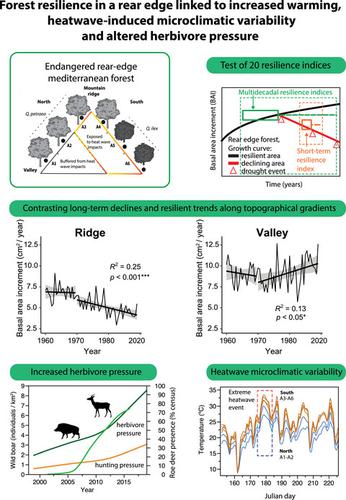Our official English website, www.x-mol.net, welcomes your feedback! (Note: you will need to create a separate account there.)
Forest resilience to global warming is strongly modulated by local-scale topographic, microclimatic and biotic conditions
Journal of Ecology ( IF 5.5 ) Pub Date : 2021-08-04 , DOI: 10.1111/1365-2745.13752 Jofre Carnicer 1, 2, 3 , Maria Vives‐Ingla 1, 2 , Laura Blanquer 1, 2 , Xavier Méndez‐Camps 1 , Carme Rosell 1 , Santi Sabaté 1, 2 , Emília Gutiérrez 1 , Teresa Sauras 1 , Josep Peñuelas 2 , Adrià Barbeta 1
中文翻译:

森林对全球变暖的复原力受到局部地形、小气候和生物条件的强烈调节
更新日期:2021-09-16
Journal of Ecology ( IF 5.5 ) Pub Date : 2021-08-04 , DOI: 10.1111/1365-2745.13752 Jofre Carnicer 1, 2, 3 , Maria Vives‐Ingla 1, 2 , Laura Blanquer 1, 2 , Xavier Méndez‐Camps 1 , Carme Rosell 1 , Santi Sabaté 1, 2 , Emília Gutiérrez 1 , Teresa Sauras 1 , Josep Peñuelas 2 , Adrià Barbeta 1
Affiliation

|
- Resilience of endangered rear edge populations of cold-adapted forests in the Mediterranean basin is increasingly altered by extreme heatwave and drought pressures. It remains unknown, however, whether microclimatic variation in these isolated forests could ultimately result in large intra-population variability in the demographic responses, allowing the coexistence of contrasting declining and resilient trends across small topographic gradients. Multiple key drivers promoting spatial variability in the resilience of rear edge forests remain largely unassessed, including amplified and buffered thermal exposure induced by heatwaves along topographic gradients, and increased herbivory pressure on tree saplings in defaunated areas lacking efficient apex predators. Here we analysed whether indicators of forest resilience to global warming are strongly modulated by local-scale topographic, microclimatic and biotic conditions.
- We studied a protected rear edge forest of sessile oak Quercus petraea, applying a suite of 20 indicators of resilience of tree secondary growth, including multidecadal and short-term indices. We also analysed sapling recruitment success, recruit/adult ratios and sapling thermal exposure across topographic gradients. We found large within population variation in secondary growth resilience, in recruitment success and in thermal exposure of tree saplings to heatwaves, and this variability was spatially structured along small-scale topographical gradients. Multidecadal resilience indices and curves provide useful descriptors of forest vulnerability to climate warming, complementing assessments based in the analysis of short-term resilience indicators. Species-specific associations of trees with microclimatic variability are reported.
- Biotic factors are key in determining long-term resilience in climatically stressed rear edge forests, with strong limitation of sapling recruitment by increased roe deer and wild boar herbivory. Our results also support non-stationary effects of climate determining forest growth responses and resilience, showing increased negative effects of warming and drought over the last decades in declining stands.
- Synthesis. Our findings do not support scenarios predicting spatially homogeneous distributional shifts and limited resilience in rear edge populations, and are more supportive of scenarios including spatially heterogeneous responses, characterised with contrasting intra-population trends of forest resilience. We conclude that forest resilience responses to climate warming are strongly modulated by local-scale microclimatic, topographic and biotic factors. Accurate predictions of forest responses to changes in climate would therefore largely benefit from the integration of local-scale abiotic and biotic factors.
中文翻译:

森林对全球变暖的复原力受到局部地形、小气候和生物条件的强烈调节
- 极端热浪和干旱压力越来越严重地改变了地中海盆地冷适应森林濒临灭绝的后缘种群的恢复能力。然而,这些与世隔绝的森林中的小气候变化是否最终会导致人口响应中的人口内部差异很大,从而允许在小地形梯度上对比下降和弹性趋势共存,这仍然是未知的。促进后缘森林恢复力空间变异性的多个关键驱动因素在很大程度上仍未得到评估,包括由沿地形梯度的热浪引起的放大和缓冲热暴露,以及缺乏有效顶端捕食者的动物区系中树苗的食草压力增加。
- 我们研究了一个受保护的无柄橡木Quercus petraea后缘森林,应用一套 20 项树木次生生长恢复力指标,包括多年期和短期指数。我们还分析了树苗招募成功率、招募/成人比率和树苗在地形梯度上的热暴露。我们发现在次生生长恢复力、招募成功和树苗对热浪的热暴露方面,种群内部存在很大差异,并且这种变异性是沿着小尺度地形梯度在空间上结构化的。多年代复原力指数和曲线提供了森林对气候变暖的脆弱性的有用描述,补充了基于短期复原力指标分析的评估。报告了树木与小气候变异的物种特异性关联。
- 生物因素是决定气候压力大的后缘森林长期恢复力的关键,狍和野猪食草动物的增加严重限制了幼苗的补充。我们的结果还支持气候决定森林生长响应和恢复力的非平稳效应,表明在过去几十年中,气候变暖和干旱对林分下降的负面影响增加。
- 合成。我们的研究结果不支持预测后缘种群空间均匀分布变化和有限弹性的情景,而更支持包括空间异质响应在内的情景,其特征是森林恢复力的种群内趋势形成鲜明对比。我们得出的结论是,森林对气候变暖的复原力响应受到局部小气候、地形和生物因素的强烈调节。因此,准确预测森林对气候变化的反应将在很大程度上受益于局部尺度非生物和生物因素的整合。


























 京公网安备 11010802027423号
京公网安备 11010802027423号